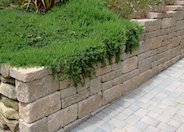
Common name:Prostrate Rosemary
Botanical name:Rosmarinus officinalis 'Prostratus'
The 'Prostratus' grows to a height of 2'-3' with a spread to 8'. Its flowers are pale, lavender blue in color; the leaves are needle-like with a dark, blue-green color. This plant makes a good ground cover, and its leaves can be used as seasoning in cooking.
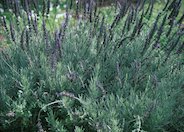
Common name:Goodwin Creek Gray Lavender
Botanical name:Lavandula 'Goodwin Creek Gray'
Lavandula 'Goodwin Creek Gray' is an evergreen shrub. This dense foliaged plant grows to 2.5'-3' high and 3'-4' wide, with silvery leaves that are toothed at the tips. Deep violet-blue flowers bloom from spring to late fall.
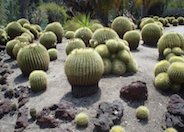
Common name:Golden Barrel Cactus
Botanical name:Echinocactus grusonii
Golden Barrel Cactus has a globe shaped trunk and vertical ribs lined with thick rows of golden spines. It grows slowly to 3' tall. It looks handsome in containers. It can thrive in full sun but prefers some shade in low desert. This cactus prefers well drained soil and rots with poor drainage.
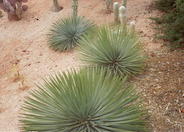
Common name:Our Lord's Candle
Botanical name:Hesperoyucca whipplei
Stemless, it produces dense clusters of rigid, gray green leaves 12"-18" long. Its drooping, bell-shaped flowers appear on large, branched spikes 3'-6' long. Plants die after blooming, much like Agaves, but only individual rosettes will die off; others in clump will continue to live and eventually bloom. Overall plant grows 3' tall and 6' wide. This CA native prefers well drained soil and is drought tolerant but will lose lower leaves with extended drought..
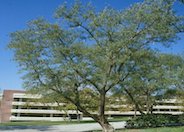
Common name:Olive
Botanical name:Olea europaea
This broad tree will grow to 40' tall and has small, gray green leaves with fleshy black fruit that appears in fall. Purchase fruitless varieties to avoid the mess.
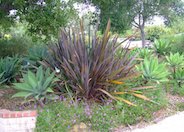
Common name:New Zealand Flax, Purple
Botanical name:Phormium tenax 'Atropurpureum'
Phormium tenax 'Atropurpureum' is an evergreen perennial. Big, dramatic plant composed of many swordlike, stiffly vertical leaves can reach 5' tall. Leaves are purple red. Flowers stems reach high above leaves, bearing clusters of 1"-2" blossoms in dark red.
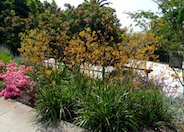
Common name:Kangaroo Paw 'Yellow'
Botanical name:Anigozanthos 'Yellow'
This herbaceous perennial can reach 4'-6' tall and 2'-3' wide. Kangaroo Paw has strap-like leaves and fuzzy tubular-shaped, yellow flowers that bloom in spring and fade as summer progresses. They can be used for cut or dried flowers. The flowers have nectar which attract hummingbirds. Kangaroo Paw does well in full sun and looks great in borders, mass plantings, and in pots. It can do well in drought tolerant conditions. It prefers sandy soil and deep, infrequent watering.
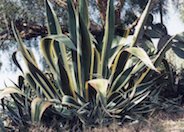
Common name:Variegated Century Plant
Botanical name:Agave americana 'Variegata'
This Agave has a creamy yellow margins around the edge of the leaves. It will grow 6'-10' tall by up to 13' wide. It is native to Mexico. It has a very open growth habit, with leaves that recurve along their length.
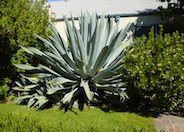
Common name:Century Plant, Maguey
Botanical name:Agave americana
This plant is fast growing to about 6'-10' tall and 8'-13' wide. Wide gray leaves have stiff terminal spines and recurved teeth on margins. It prefers full sun and well-drained situations. After blooming, which could take several years, it will die but will send up new pups from around the base. Some people are allergic to the sap. Removal is difficult if unwanted.
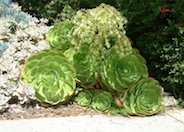
Common name:Parasol Aeonium
Botanical name:Aeonium arboreum
Parasol Aeonium is an upright succulent with rosette leaf clusters. It forms a mound and can be easily propagated by cuttings.
| Designer: | Pleasing to the Eye |
Photographer: GardenSoft |
Soils and Compost:
Maintain a two to four inch layer of mulch on the soil surface to reduce weeds, infiltrate rain water, and reduce compaction.
Water Saving Tip:
Adjust sprinklers to avoid watering sidewalks and driveways.
Integrated Pest Management:
Drip and other smart irrigation delivers water directly to roots, allowing no excess water for weeds.

